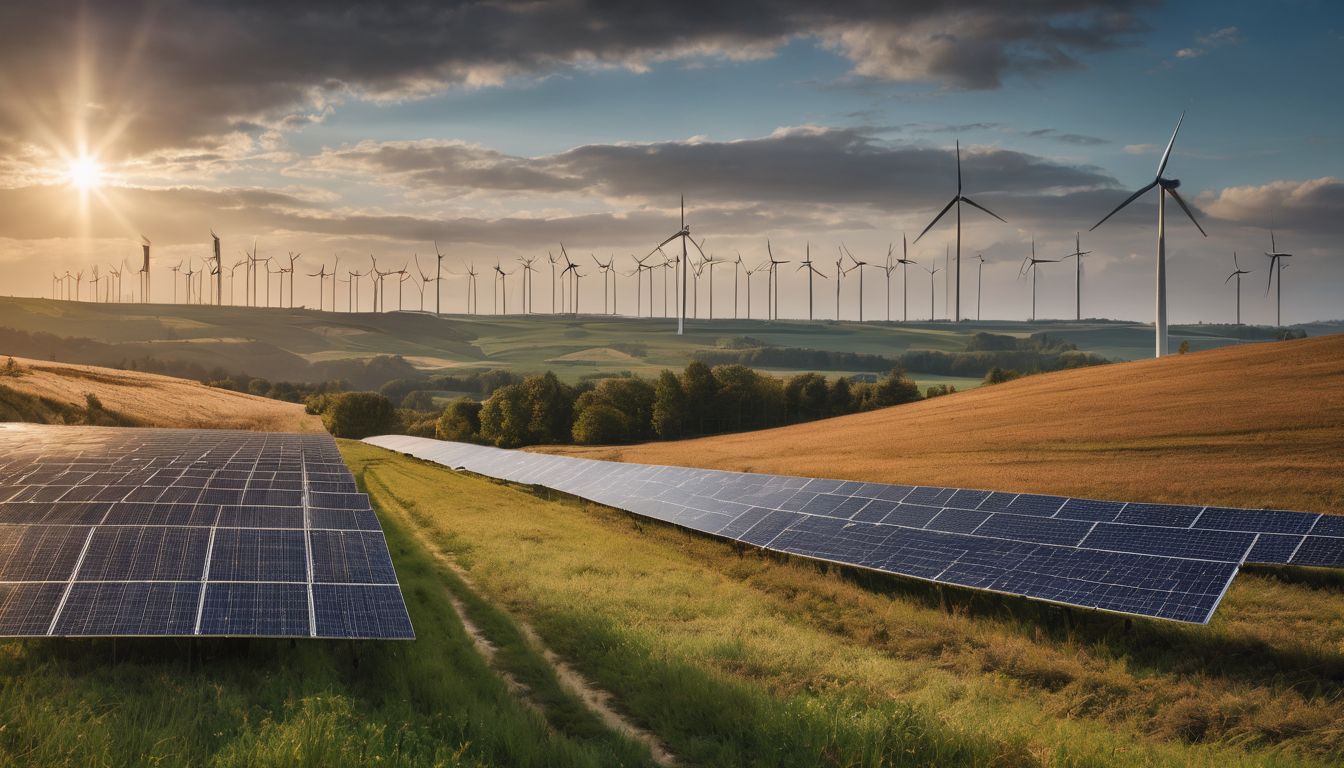As winter’s chill creeps in, keeping our homes warm without breaking the bank becomes a growing concern. Geothermal heating systems harness the steady underground temperature to heat and cool your home more efficiently than conventional methods.
This guide offers you a deep dive into how these systems work and their potential savings on energy costs. Discover a warmer future with eco-friendly flair!
Key Takeaways
- Geothermal heating and cooling systems use the constant temperature of the earth to efficiently heat and cool buildings, reducing reliance on fossil fuels and cutting energy costs.
- Installation involves drilling into the ground to install a loop system that connects to an indoor heat pump; these systems are adaptable for different property types including new constructions, existing homes, or historic buildings.
- While initial installation costs can be higher than conventional systems, long-term savings on utility bills and potential government incentives make geothermal a cost-effective solution.
- Geothermal energy is environmentally friendly, producing minimal air pollutants, conserving natural resources, requiring little land space, and significantly reducing carbon emissions.
- Homeowners interested in switching to geothermal should research reputable installation companies, assess home suitability for a system, explore financing options or incentives available, and prepare their home for installation.
Understanding Geothermal Heating and Cooling
Geothermal heating and cooling systems use the earth’s natural heat to warm or cool a building, making them highly energy efficient. The system works by transferring heat between the ground and the building using a series of pipes and a heat pump.
What is geothermal heating and cooling?
Geothermal heating and cooling tap into the stable thermal energy found just beneath the Earth’s surface. This system uses that consistent underground temperature to heat and cool homes and buildings, providing a sustainable solution for energy-efficient home comfort.
By harnessing this renewable resource, geothermal systems reduce reliance on fossil fuels and present an environmentally friendly alternative to traditional HVAC units.
The technology relies on ground source heat pumps to move warmth from the ground into your space during winter, or pull excess heat from indoors and transfer it back into the earth in summer months.
These cycles offer both heating and cooling design within one setup, making geothermal solutions incredibly versatile for residential geothermal heating as well as commercial applications.
The result is a comfortable indoor environment throughout various seasons while significantly cutting down on greenhouse emissions associated with standard air source heat pumps.
How does it work?
Geothermal heating and cooling systems work by leveraging the stable temperature of the earth to provide energy-efficient heating and cooling for homes. A ground-source heat pump is at the core of this system, using a network of pipes buried in the ground to transfer heat between your home and the earth.
This process harnesses renewable geothermal energy, drawing warmth from the ground during winter and depositing excess indoor heat into the ground during summer. The pump’s operation is driven by electricity, making it an environmentally friendly alternative to traditional heating methods.
By circulating water or antifreeze through underground loops where it absorbs thermal energy, geothermal systems are capable of providing consistent air temperatures within a building throughout all seasons.
With minimal impact on natural resources, these sustainable heating and cooling solutions are gaining popularity as homeowners seek eco-friendly alternatives that reduce their carbon footprint while maintaining comfortable living environments.
Components of a geothermal system
The components of a geothermal system include the heat exchanger, which transfers heat between the ground and the home’s heating and cooling system. The ground loop, consisting of pipes buried underground, absorbs and releases heat from the earth. The heat pump, an essential part of the system, moves the heat between the ground and the building. The ductwork or radiant heating system distributes warm or cool air throughout the home efficiently. Lastly, the thermostat regulates the temperature to maintain a comfortable indoor environment.
Advantages and Cost-Effectiveness of Geothermal Systems
Geothermal heating and cooling systems offer numerous benefits such as lower operating costs, reduced environmental impact, and consistent comfort. The initial investment may be higher, but the long-term cost savings make geothermal systems a cost-effective choice for environmentally conscious homeowners.
Benefits of using geothermal heating and cooling
- Lower operational costs due to higher energy efficiency.
- Reduced environmental impact by utilising renewable energy sources.
- Consistent and reliable performance throughout the year.
- Long lifespan with minimal maintenance requirements.
- Improved indoor air quality through filtration features.
- Enhanced property value and potential eligibility for government incentives.
- Flexibility to integrate with existing HVAC systems for optimal comfort.
Cost considerations
Cost considerations play a significant role when evaluating the adoption of geothermal heating and cooling systems. The upfront investment might be higher compared to traditional systems, yet over time, the energy savings can outweigh the initial costs. Here are key financial factors to consider:
| Cost Factor | Details |
|---|---|
| Installation Costs | Includes drilling, equipment, and labour; typically higher than conventional systems. |
| Energy Savings | Reduction in monthly utility bills due to higher efficiency; savings accrue over time. |
| Maintenance Expenses | Lower than traditional HVAC systems; fewer moving parts lead to less wear and tear. |
| Government Incentives | Various grants, tax credits, and rebates may be available to offset costs. |
| Resale Value | Homes with geothermal systems may have higher resale values. |
| Life Span | Geothermal systems can last up to 25 years for indoor equipment and 50+ for ground loops. |
| Financing Options | Loans, leases, and power purchase agreements can assist with spreading out costs. |
With cost factors outlined, it becomes clearer how geothermal systems are an investment for the long-term. Now, let’s delve into the installation process and how these systems can fit various home types.
Installation and Adaptability of Geothermal Systems
The installation process for geothermal heating and cooling systems involves drilling or digging to access the earth’s constant temperature. These systems can be adapted to different types of homes, making them a versatile and efficient option for residential and commercial properties alike.
The installation process
Geothermal heating and cooling systems involve a detailed installation process, considering different factors and components for effective functioning. Here’s a breakdown of the installation process:
- Drilling boreholes into the ground to access the geothermal heat reservoir.
- Installing a loop system, which circulates water or antifreeze through the underground pipes to absorb or release heat.
- Connecting the loop to a heat pump inside the property, which extracts heat from the fluid and distributes it throughout the building.
- Integrating a ductwork system for efficient distribution of heated or cooled air within the premises.
- Testing and calibrating the entire system for optimal performance and energy efficiency.
Adapting to different types of homes
Transitioning from the installation process to adapting geothermal systems to different homes requires considering various property types and layouts. Geothermal heating and cooling can be adapted for residential, commercial, and even industrial properties.
Whether you have a new construction, an existing home, or a historic building, geothermal systems can be customized to fit your property’s specific needs.
When it comes to adapting geothermal systems to different types of homes, whether small or large-scale, aspects such as available land space for ground loops or suitability for vertical boreholes need evaluation.
Addressing Common Questions about Geothermal Energy
Thinking about making the switch to geothermal energy for your home? Learn about how geothermal heating and cooling works, its efficiency, costs involved, and whether it’s suitable for your home.
How geothermal heating and cooling works
Geothermal heating and cooling systems work by utilising the stable temperature of the Earth to heat and cool buildings. A ground-source heat pump is installed, which circulates a water-based solution through a loop of pipes buried underground.
The solution absorbs heat from the ground in winter and transfers it indoors, while in summer, it extracts indoor heat and deposits it into the ground. This process provides energy-efficient heating and cooling for homes while significantly reducing carbon emissions.
Using renewable geothermal energy minimises reliance on traditional fossil fuels, making it an environmentally friendly choice for home comfort. By harnessing the Earth’s natural energy, geothermal systems offer a reliable and sustainable way to keep homes comfortable throughout the year while contributing to conservation efforts.
The efficiency of geothermal energy
Maximising the efficiency of geothermal energy is crucial for reducing energy costs and minimising environmental impact. Geothermal systems consistently provide high efficiency by extracting heat from the ground, which maintains a stable temperature year-round.
This results in significant energy savings compared to traditional heating and cooling methods, making geothermal systems an ideal choice for environmentally conscious individuals looking to reduce their carbon footprint while enjoying affordable home comfort.
Furthermore, the longevity and durability of geothermal systems contribute to their overall efficiency, offering long-term reliability and low maintenance requirements.
In addition to delivering reliable performance and cost savings, the efficiency of geothermal energy also supports sustainable living by significantly reducing greenhouse gas emissions.
By harnessing renewable energy sources from below the Earth’s surface, geothermal heating and cooling play a vital role in promoting clean air quality and preserving natural resources for future generations.
Costs involved
Installing a geothermal heating and cooling system involves upfront costs, including equipment, labor, and drilling for the ground loop. However, over time, you can expect significant savings on your energy bills due to the high efficiency of geothermal systems.
The initial investment is offset by lower monthly utility expenses – making it a cost-effective choice in the long run. Plus, there are potential financial incentives and tax credits available for installing renewable energy systems like geothermal heat pumps.
To ensure that you understand the total costs involved with adopting a geothermal system for your home or business, it’s essential to consult with a qualified professional who can provide an accurate assessment based on your specific needs and property.
Is it suitable for my home?
Geothermal heating and cooling systems are suitable for various types of homes, from single-family dwellings to larger commercial properties. The adaptability of geothermal systems makes them a viable option for environmentally conscious individuals looking for energy-efficient home heating and cooling solutions.
With the ability to provide consistent and reliable temperature control throughout the year, geothermal heat pumps are an attractive choice for those seeking green energy alternatives.
Whether you have a small residential property or a large commercial building, geothermal systems offer a sustainable way to reduce your carbon footprint while enjoying cost-effective and efficient heating and cooling.
The suitability of geothermal systems extends beyond traditional residential structures, making it an appealing option for those interested in sustainable living or running eco-friendly businesses.
Environmental Impact and Next Steps
The environmental impact of geothermal energy is significant, with reduced greenhouse gas emissions and reliance on fossil fuels. For those interested in making the switch to geothermal heating and cooling, the next steps would involve conducting a feasibility assessment for your home and contacting a qualified professional for installation.
The environmental advantages of geothermal energy
Geothermal heating and cooling systems have a minimal environmental impact. By utilising the constant temperature of the earth, they reduce greenhouse gas emissions and dependence on fossil fuels.
- Geothermal energy produces almost no air pollutants, resulting in cleaner air and improved respiratory health for everyone.
- This renewable energy source doesn’t deplete natural resources and helps in the conservation of our planet’s finite resources.
- Geothermal systems require very little land space, minimising habitat destruction and preserving natural landscapes.
- The technology has a long lifespan and low maintenance requirements, reducing waste and promoting sustainability.
- Utilising geothermal energy contributes to a significant reduction in carbon emissions, playing a role in combating climate change.
Making the switch to geothermal
Consider the following when making the switch to geothermal heating and cooling:
- Evaluate your property’s feasibility for installing a geothermal system, taking into account soil conditions, available space, and existing heating and cooling systems.
- Contact a reputable geothermal HVAC contractor to conduct a thorough assessment of your property and provide recommendations for the most suitable system for your home.
- Research available incentives, rebates, and financing options to help offset the initial investment in a geothermal system.
- Obtain multiple quotes from different geothermal installation companies to ensure competitive pricing and comprehensive service offerings.
- Prepare your home for geothermal installation by ensuring proper insulation, air sealing, and ductwork modifications as recommended by the installation team.
- Familiarise yourself with maintenance requirements and operation of the new geothermal system to ensure its optimal performance and longevity.
- Connect with local community groups or online forums to learn from others who have made the switch to geothermal heating and cooling systems.
Next steps for those interested in geothermal heating and cooling.
- Making the switch to geothermal offers long – term benefits.
- Research reputable companies in your area that specialise in geothermal heating and cooling installation.
- Schedule a consultation to assess your home’s suitability for a geothermal system.
- Explore available financing options or incentives for switching to geothermal energy.
- Consider the maintenance requirements and long-term cost savings.
- Engage with local community groups or online forums to learn from others who have made the transition.
- Prepare your home for the installation process by discussing any necessary modifications with the installation team.
- Educate yourself on the environmental impact and overall benefits of geothermal energy by reading reputable sources.
- Take steps towards reducing your carbon footprint through sustainable choices beyond just heating and cooling.
Conclusion
In conclusion, geothermal heating and cooling provide an energy-efficient and sustainable option for environmentally conscious individuals. The installation process is adaptable to different types of homes, making it a viable choice for many homeowners.
By considering the environmental impact and benefits, those interested in geothermal systems can take the next steps towards a more eco-friendly home heating and cooling solution.
FAQs
1. What is a geothermal heating system and how does it work?
A geothermal heating system draws heat from the ground using ground source heat pumps to provide energy-efficient home heating and cooling.
2. Are geothermal systems better than air-source heat pumps?
Yes, typically geothermal systems are more efficient than air-source heat pumps because they use consistent underground temperatures for energy-efficient heating and cooling.
3. Can I use a geothermal system for both warming and cooling my home?
Absolutely! Geothermal heat systems can keep your home warm in the winter and serve as a cool option during the summer months.
4. Is it worth investing in a commercial geothermal heating and cooling system?
Investing in commercial geothermal heating and cooling offers long-term savings on energy bills due to its high efficiency compared to traditional methods of climate control.





